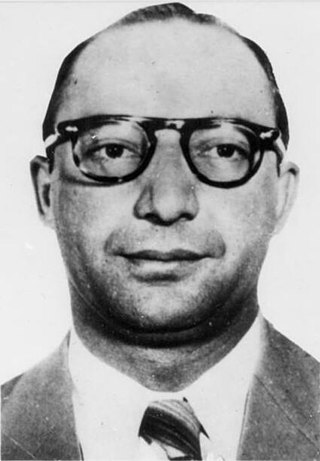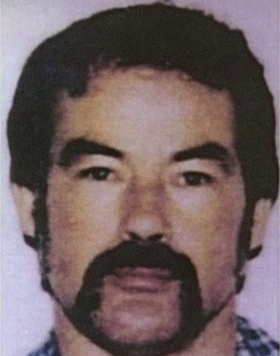The Boston Strangler is the name given to the murderer of 13 women in Greater Boston during the early 1960s. The crimes were attributed to Albert DeSalvo based on his confession, on details revealed in court during a separate case, and DNA evidence linking him to the final victim.
The Bridgewater Four are four men who were tried and found guilty of killing 13-year-old paperboy Carl Bridgewater, who was shot in the head at close range near Stourbridge, England, in 1978. In February 1997, after almost two decades of imprisonment, their convictions were overturned and the three surviving defendants were released; the fourth defendant had died in prison two years into his sentence. Bridgewater's murder remains unsolved.
The Walsh Street police shootings were the 1988 murders of two Victoria Police officers: Constables Steven Tynan, 22, and Damian Eyre, 20.
The M25 Three were Raphael Rowe, Michael George Davis, and Randolph Egbert Johnson, who were jailed for life at the Old Bailey in March 1990 after being wrongfully convicted of murder and burglary. The name was taken from the location of the crimes, which were committed around the M25, London's orbital motorway, during the early hours of 16 December 1988. The original trial took place between January and February 1990, resulting in all three being convicted of the murder of Peter Hurburgh, causing grievous bodily harm with intent to Timothy Napier and several robberies. Each was sentenced to life imprisonment for the murder and given substantial sentences for the other offences. The convictions were overturned in July 2000. All three men have consistently maintained their innocence.
This is a timeline of major crimes in Australia.
The Shark Arm case refers to a series of incidents that began in Sydney, Australia, on 25 April 1935 when a human arm was regurgitated by a captive 3.5-metre tiger shark, resulting subsequently in a murder investigation and trial.
Wrongful execution is a miscarriage of justice occurring when an innocent person is put to death by capital punishment. Cases of wrongful execution are cited as an argument by opponents of capital punishment, while proponents say that the argument of innocence concerns the credibility of the justice system as a whole and does not solely undermine the use of the death penalty.
William Herbert Wallace was an Englishman convicted in 1931 of the murder of his wife, Julia, in their home in Wolverton Street in Liverpool's Anfield district. Wallace's conviction was later overturned by the Court of Criminal Appeal, the first instance in British legal history where an appeal had been allowed after re-examination of evidence. The case, with its strange background, has long been the subject of speculation and has generated many books, being regarded internationally as a classic murder mystery.

Vernon C. "Verne" Miller was a freelance Prohibition hitman, bootlegger, bank robber and the disgraced former sheriff of Beadle County, South Dakota. Most infamously, Miller, as the only identified gunman in the Kansas City massacre, was found beaten and strangled to death shortly after the incident.

Anthony Brancato was an American criminal who served as a freelance gunman to various Mafia and syndicate organizations.
The Burger Chef murders took place at a Burger Chef restaurant in Speedway, Indiana, United States, on the night of Friday, November 17, 1978. Four young employees went missing in what was initially thought to be a petty theft of cash from the restaurant's safe. By Saturday morning it became a clear case of robbery-kidnapping, and by Sunday, when their bodies were discovered, a case of murder. While investigators believe they have identified some or all of the perpetrators, without physical evidence they have not been able to prosecute those who remain alive.
The 1978 Blackfriars Massacre, also known as the Blackfriars murders, is an unsolved Irish Mob and/or Italian-American Mafia massacre that occurred on June 28, 1978, in the Blackfriars Pub in Downtown Boston, Massachusetts. Four criminals known to the police and a former Channel 7 Boston television investigative news anchorman, Jack Kelly, were killed, allegedly over the sale of cocaine.

The Father's Day Bank Massacre was a bank robbery and shooting that took place on Sunday, June 16, 1991, at the United Bank Tower in Denver, Colorado. The perpetrator killed four unarmed bank guards and held up six tellers in the bank's cash vault. An estimated $200,000 was stolen from the bank. Nearly three weeks later, on July 4, 1991, authorities arrested retired police officer James W. King for the crime. The subsequent trial was broadcast nationally on Court TV. After days of deliberation, the jury acquitted King. None of the stolen money was ever found. The crime remains unsolved and is considered a cold case.

Ivan Robert Marko Milat, commonly referred to in media as the Backpacker Murderer, was an Australian serial killer who abducted, assaulted, robbed and murdered two men and five women in New South Wales between 1989 and 1992. His modus operandi was to approach backpackers along the Hume Highway under the guise of providing them transport to areas of southern New South Wales, then take his victims into the Belanglo State Forest where he would incapacitate and murder them. Milat is also suspected of having committed many other similar offences and murders around Australia.

David Groves, better known by his birth name Patrick David Mackay, is a British serial killer who is believed to be one of the United Kingdom's most prolific serial murderers.

Jason Martin-Smith was an English man murdered in Hastings, East Sussex. He was considered a missing person as the case went unsolved for 14 years, until Mark Searle was found guilty of murder at Lewes Crown Court in August 2015. Steve McNicol was also convicted of conspiracy to kidnap, while a third suspect, Frank Torpey, died before proceedings began.
Chris Clark is a British amateur crime writer who writes chiefly about serial killers and their supposed links to unsolved crimes. He is a retired police intelligence officer who worked in the King's Lynn area for Norfolk Police, although his career was somewhat unsuccessful and he had three applications to join the new National Criminal Intelligence Service rejected in 1993, with the commanding officers unimpressed by his record and applications. In 2022, his book Yorkshire Ripper: The Secret Murders, which was jointly written with journalist Tim Tate and alleged links between Peter Sutcliffe and unsolved murders, was made into an ITV prime-time documentary series of the same name.
On 22 August 2022, Olivia Pratt-Korbel, a nine-year-old girl, was shot by a masked gunman in Liverpool, England, and was pronounced dead the same day at the city's Alder Hey Children's Hospital. The attack took place at the doorstep of Pratt-Korbel's family home in Dovecot; the intended target of the attack was a 35-year-old gang member who had criminal convictions for drug dealing and burglary. During the attack, Pratt-Korbel was with her mother. A shot by the gunman passed through her mother's wrist and Pratt-Korbel's chest.





